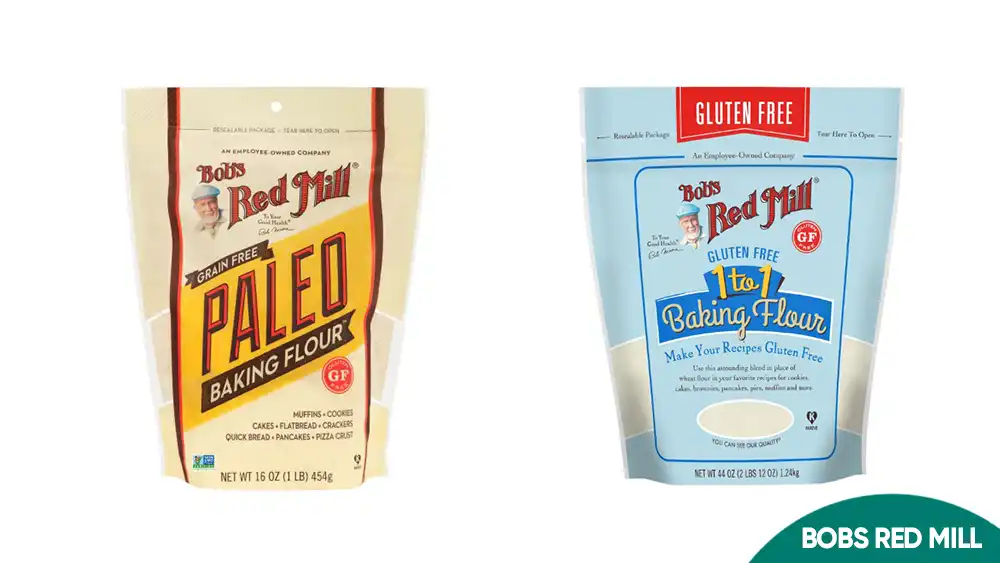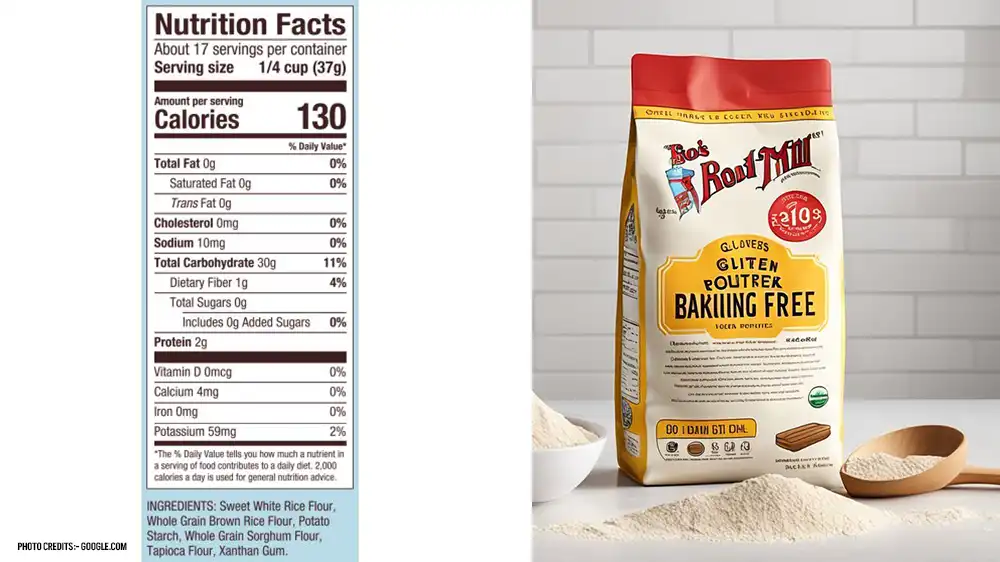
HEALTH BLOG
Bob's Red Mill Gluten-Free Flour: History, Uses, and Health Benefits
-
Rahul Priydarss
Discover the benefits of Bob’s Red Mill Gluten-Free Flour in our comprehensive guide. This versatile flour blend is made from a mix of gluten-free grains, including rice, sorghum, and tapioca, perfect for those with celiac disease or gluten sensitivities. Learn about its history, nutritional advantages, and how it compares to competitors. Explore top recipes, understand gluten-free baking techniques, and find out where to buy this high-quality flour. With Bob’s Red Mill Gluten-Free Flour, enjoy delicious and healthy baked goods without compromising on taste or texture. Enhance your gluten-free cooking with our expert insights and tips.
Introduction to Bob’s Red Mill Gluten-Free Flour:
Bob’s Red Mill Gluten-Free Flour has become a popular choice for individuals seeking gluten-free alternatives for their baking and cooking needs. As a versatile and high-quality flour, it is designed to replace wheat flour in various recipes while maintaining texture and flavor. Bob’s Red Mill ensures that their gluten-free flour is produced in a dedicated gluten-free facility, providing peace of mind for those with gluten sensitivities or celiac disease. The flour is made from a blend of gluten-free grains such as rice, sorghum, and tapioca, making it suitable for a wide range of recipes, from bread and cookies to pancakes and pizza crusts.
What is Bob’s Red Mill:
Bob’s Red Mill Gluten-Free Flour is a premium blend of gluten-free grains designed as an alternative to traditional wheat flour. It is specifically crafted for those who need to avoid gluten due to celiac disease, gluten sensitivities, or personal preferences. This flour is produced in a dedicated gluten-free facility to prevent cross-contamination, ensuring its safety for gluten-intolerant individuals. The blend typically includes grains like rice, sorghum, and tapioca, offering a neutral flavor and smooth texture, making it suitable for various baked goods such as bread, cakes, cookies, and other recipes.

Table of Contents
History and Origin of Bob’s Red Mill Gluten-Free Flour:
Bob’s Red Mill Gluten-Free Flour traces its roots back to the founding of Bob’s Red Mill Natural Foods in 1978 by Bob Moore and his wife, Charlee. With a vision of providing wholesome, natural foods to the public, Bob’s Red Mill began as a producer of stone-ground whole grains and cereals. The demand for gluten-free products grew over time, particularly as awareness of celiac disease and gluten sensitivity increased. In response, Bob’s Red Mill introduced their gluten-free flour line in the early 2000s.
The gluten-free flour was developed to offer a safe and reliable substitute for wheat flour, meeting the needs of the growing gluten-free community. To ensure the highest quality, Bob’s Red Mill established a dedicated gluten-free facility, preventing any cross-contamination. This innovation helped Bob’s Red Mill become a leader in the gluten-free market, earning trust from consumers worldwide for their commitment to quality and safety.
Why Choose Gluten-Free Flour?:
Choosing gluten-free flour is essential for individuals with celiac disease or gluten sensitivity, as it allows them to enjoy baked goods and other recipes without triggering adverse health reactions. Gluten-free flour provides a safe alternative to wheat-based flour by eliminating gluten protein, which can cause digestive issues and inflammation in sensitive individuals. Beyond medical reasons, some people opt for gluten-free flour as part of a health-conscious diet or to experiment with diverse grains.
Gluten-free flour blends, like Bob’s Red Mill Gluten-Free Flour, offer versatility, mimicking the texture and performance of traditional flour in a wide range of recipes. It can be used to make bread, cookies, cakes, and other treats without sacrificing taste or quality. Additionally, gluten-free flour often contains a blend of nutrient-rich grains like sorghum, rice, and tapioca, offering a more wholesome option for those seeking balanced nutrition.
What is Gluten?:
Gluten is a group of proteins found primarily in wheat, barley, and rye. It is responsible for the elasticity and chewy texture in dough, helping it rise and maintain its shape during baking. Gluten consists of two main proteins, glutenin, and gliadin, which combine to form a sticky, elastic network when mixed with water. This network traps air and gives structure to bread and other baked goods.
While gluten is harmless for most people, it can cause adverse reactions in individuals with celiac disease or gluten sensitivity. For those with celiac disease, consuming gluten triggers an immune response that damages the small intestine, leading to digestive issues, malnutrition, and other health problems. For those with gluten sensitivity, gluten can cause symptoms like bloating, fatigue, and stomach discomfort. This is why gluten-free products, such as gluten-free flour, are crucial for those needing to avoid gluten.
Nutritional Benefits of Gluten-Free Flour:
Gluten-free flour offers a range of nutritional benefits, depending on the type of flour used in the blend. These flours are often made from whole grains, nuts, or seeds, providing different vitamins, minerals, and health benefits. Here are some of the key nutritional benefits of common gluten-free flours.
Higher Fiber Content: Many gluten-free flours, such as almond flour, brown rice flour, and coconut flour, are rich in fiber, which aids in digestion, supports gut health, and helps maintain steady blood sugar levels. Fiber also promotes feelings of fullness, which can help with weight management.
Rich in Protein: Gluten-free flours like almond flour, chickpea (garbanzo bean) flour, and quinoa flour are excellent sources of plant-based protein. This helps support muscle health, tissue repair, and overall body function, making them ideal for those on plant-based diets or looking to increase their protein intake.
Essential Vitamins and Minerals: Gluten-free flours made from whole grains or nuts are often packed with essential nutrients. For example, almond flour is high in vitamin E, which acts as an antioxidant, while sorghum flour contains magnesium, iron, and B vitamins that support energy production and immune function. Brown rice flour offers manganese and selenium, which are important for bone health and metabolism.
Healthy Fats: Flours like almond flour and coconut flour contain healthy fats that are beneficial for heart health, cognitive function, and skin health. These fats also help provide long-lasting energy and are key components of ketogenic and low-carb diets.
Lower Glycemic Index: Many gluten-free flours, particularly almond flour and coconut flour, have a lower glycemic index than wheat flour. This means they have less of an impact on blood sugar levels, which can help in managing diabetes and reducing the risk of blood sugar spikes and crashes.
Gluten-Free and Anti-Inflammatory: For individuals with celiac disease or gluten sensitivity, gluten-free flours prevent the inflammation and digestive discomfort caused by gluten consumption. These flours allow people to enjoy baked goods without the negative side effects of gluten, supporting better overall health and well-being.
Allergy-Friendly: Many gluten-free flours are suitable for people with additional allergies or dietary restrictions. For example, coconut flour and rice flour are often used in recipes that need to be free from both gluten and nuts, making them versatile for different dietary needs.
Ingredients in Bob’s Red Mill Gluten-Free Flour:
Here’s a table outlining the typical ingredients in Bob’s Red Mill Gluten-Free Flour blend, along with their quantities:
| Ingredient | Quantity |
|---|---|
| Rice Flour | 45% |
| Tapioca Flour | 25% |
| Potato Starch | 20% |
| Sorghum Flour | 10% |
| Xanthan Gum | 0.5% |
Note: The specific proportions can vary slightly based on the blend and product version. For the most accurate and current ingredient list, refer to the product packaging or Bob’s Red Mill’s official website.
Bob’s Red Mill Gluten Free Flour Pancakes:
When using Bob’s Red Mill Gluten Free Flour for pancakes, the process is quite similar to regular pancake recipes. Mix the flour with eggs, milk (or a dairy-free alternative), a sweetener of your choice, and a leavening agent like baking powder to achieve the perfect rise. These pancakes cook up light and tender with a delightful texture, making them a great option for anyone with gluten sensitivities or those looking to enjoy a classic breakfast with a gluten-free twist.
Bob’s Red Mill Gluten Free Flour Bread:
To make gluten-free bread using Bob’s Red Mill Gluten Free Flour, you’ll need typical bread ingredients such as yeast, warm water, eggs (or an egg substitute), oil, and a little sugar to help the yeast activate. This gluten-free bread dough is generally more batter-like than traditional bread dough but bakes beautifully when given the proper time to rise. Many recipes also suggest adding xanthan gum or psyllium husk to help with binding and elasticity, which are usually provided by gluten in traditional flour.
Bob’s Red Mill Gluten Free Flour Glyphosate:
Bob’s Red Mill takes pride in producing high-quality, natural products, including their Gluten Free Flour. One topic of concern that occasionally arises among consumers is the presence of glyphosate, a common herbicide used in conventional farming. Bob’s Red Mill has stated that they do not intentionally add glyphosate to their products. Additionally, they source ingredients from trusted suppliers and work to meet the highest food safety standards.
However, like many agricultural products, trace amounts of glyphosate can sometimes be present due to environmental factors or cross-contamination during farming and processing. Consumers who are concerned about glyphosate in their food often opt for organic options, as organic farming prohibits the use of synthetic herbicides like glyphosate.

Understanding Gluten-Free Baking:
Gluten-free baking involves using alternative flours and ingredients to create baked goods without gluten, a protein found in wheat, barley, and rye. Since gluten provides elasticity and structure to traditional doughs and batters, gluten-free baking requires a different approach to achieve similar results.
One of the key elements in gluten-free baking is the use of a blend of gluten-free flours, such as rice, sorghum, almond, or tapioca flour, to mimic the texture of wheat flour. However, these flours alone may not offer the same binding and rising properties as gluten. To compensate, ingredients like xanthan gum, guar gum, or psyllium husk are often added to provide elasticity and structure.
Gluten-free baking can be more sensitive to moisture content, as gluten-free flours tend to absorb liquid differently. Bakers may need to adjust liquid ratios and use binding agents like eggs, flaxseeds, or chia seeds to create a cohesive dough or batter.
Despite the challenges, gluten-free baking allows those with celiac disease, gluten sensitivities, or dietary preferences to enjoy a wide range of baked goods. With the right techniques and ingredient combinations, gluten-free versions of bread, cakes, cookies, and other treats can be just as delicious and satisfying as their traditional counterparts.
Types of Bob’s Red Mill Gluten-Free Flour:
Bob’s Red Mill offers a variety of gluten-free flours, each designed to cater to different baking needs and preferences. Here are some of the popular types.
Bob’s Red Mill Gluten-Free 1-to-1 Baking Flour: This versatile blend is made to substitute regular flour in a one-to-one ratio for most traditional baking recipes. It contains a mix of rice flour, sorghum flour, potato starch, and tapioca flour, along with xanthan gum to provide elasticity and binding, making it ideal for cookies, cakes, and other baked goods.
Bob’s Red Mill Almond Flour: Made from finely ground blanched almonds, this flour is gluten-free and rich in protein, healthy fats, and vitamins. It has a moist, slightly sweet flavor and is perfect for low-carb, keto, and paleo baking, as well as for making pancakes, cookies, and breads.
Bob’s Red Mill Coconut Flour: Coconut flour is made from dried coconut meat and is naturally gluten-free, high in fiber, and low in carbs. It is a popular choice for paleo and keto baking, though it requires a greater amount of liquid due to its absorbent nature. It’s ideal for muffins, cakes, and cookies.
Bob’s Red Mill Garbanzo Bean Flour: Also known as chickpea flour, this gluten-free option is made from ground garbanzo beans. It’s high in protein and fiber and is often used in savory recipes, such as flatbreads, and falafel, or as a thickener for soups and sauces.
Bob’s Red Mill Sorghum Flour: Sorghum flour is mild in flavor, gluten-free, and highly nutritious, containing protein, fiber, and antioxidants. It’s typically used in combination with other gluten-free flour to make baked goods such as bread, muffins, and pancakes.
Bob’s Red Mill Tapioca Flour: Extracted from the root of the cassava plant, tapioca flour is a starchy, gluten-free flour that provides chewiness and crispness to baked goods. It’s often used in combination with other flour in recipes like bread, cakes, and pie crusts.
Bob’s Red Mill Brown Rice Flour: Brown rice flour is made from whole-grain brown rice and is a staple in gluten-free baking. It has a mild, slightly nutty flavor and is commonly used in recipes for bread, muffins, and cookies.
How to Use Gluten-Free Flour in Baking:
Using gluten-free flour in baking requires some adjustments to ensure that your recipes turn out well. Here are key tips to help you successfully bake with gluten-free flour.
Understand Flour Blends: Many gluten-free recipes call for specific flour blends, which combine different types of gluten-free flours (such as rice flour, sorghum flour, and tapioca flour) to achieve a balanced texture and flavor. Bob’s Red Mill Gluten-Free 1-to-1 Baking Flour is a popular choice for general baking, as it can be used as a direct substitute for wheat flour in most recipes.
Add Binding Agents: Since gluten is responsible for the elasticity and structure in traditional baking, gluten-free flours often require binding agents to achieve similar results. Common binders include xanthan gum, guar gum, or psyllium husk. These ingredients help to provide the dough or batter with the elasticity and cohesion it needs. Typically, you’ll use about 1/4 to 1/2 teaspoon of xanthan gum per cup of gluten-free flour.
Adjust Liquid Ratios: Gluten-free flours often absorb liquid differently from wheat flour, so you might need to adjust the amount of liquid in your recipe. Start with the amount specified in your recipe and gradually add more liquid if needed to achieve the desired consistency. Gluten-free batters and doughs may be thicker or thinner than their wheat-based counterparts.
Use Fresh Ingredients: Gluten-free flours can vary in texture and quality, so using fresh, high-quality ingredients is crucial. Stale or old flour can affect the texture and flavor of your baked goods. Store gluten-free flours in an airtight container and in a cool, dry place to maintain their freshness.
Incorporate Other Ingredients: Adding ingredients like eggs, flaxseeds, or chia seeds can improve the texture and moisture of gluten-free baked goods. These ingredients act as additional binding agents and help to enhance the structure and richness of the final product.
Mix Flours for Better Results: Blending different gluten-free flours can improve the taste and texture of your baked goods. For example, combining rice flour with almond flour or coconut flour can create a more balanced and flavorful product. Experimenting with different flour combinations can help you find the perfect mix for your recipes.
Allow Time for Resting: Gluten-free batters and doughs often benefit from resting before baking. Allowing the mixture to sit for 15 to 30 minutes can help the flours absorb the liquids better and improve the final texture.
Be Patient and Practice: Baking with gluten-free flour can involve a bit of trial and error. It’s helpful to start with recipes specifically designed for gluten-free ingredients and gradually experiment with substitutions and adjustments. With practice, you’ll get a better understanding of how different gluten-free flours behave and how to achieve the best results.
Best Recipes for Bob’s Red Mill Gluten-Free Flour:
Bob’s Red Mill Gluten-Free Flour is versatile and can be used in a variety of recipes. Here are some popular recipes to try.
Gluten-Free Pancakes:
- Ingredients: Bob’s Red Mill Gluten-Free 1-to-1 Baking Flour, baking powder, salt, eggs, milk (or dairy-free alternative), butter (or oil).
- Instructions: Mix the dry ingredients, then combine with the wet ingredients until smooth. Cook on a hot griddle until bubbles form on the surface, then flip and cook until golden brown.
Gluten-Free Chocolate Chip Cookies:
- Ingredients: Bob’s Red Mill Gluten-Free 1-to-1 Baking Flour, butter, brown sugar, granulated sugar, eggs, vanilla extract, baking soda, salt, chocolate chips.
- Instructions: Cream together the butter and sugars, then mix in the eggs and vanilla. Add the dry ingredients and chocolate chips. Scoop dough onto baking sheets and bake at 350°F (175°C) until edges are golden.
Gluten-Free Banana Bread:
- Ingredients: Bob’s Red Mill Gluten-Free 1-to-1 Baking Flour, ripe bananas, sugar, eggs, melted butter, baking soda, salt.
- Instructions: Mash the bananas and mix with the other wet ingredients. Combine with the dry ingredients and pour into a greased loaf pan. Bake at 350°F (175°C) until a toothpick inserted in the center comes out clean.
Gluten-Free Pizza Crust:
- Ingredients: Bob’s Red Mill Gluten-Free 1-to-1 Baking Flour, yeast, sugar, salt, warm water, olive oil.
- Instructions: Mix the yeast and sugar in warm water and let sit until bubbly. Combine with flour, salt, and olive oil to form a dough. Let rise, then roll out and bake at 450°F (230°C) with your favorite toppings.
Health Benefits of Bob’s Red Mill Gluten-Free Flour:
Bob’s Red Mill Gluten-Free Flour offers several health benefits, particularly for those with specific dietary needs or preferences. Here are some key advantages.
Suitable for Gluten Sensitivities: Bob’s Red Mill Gluten-Free Flour is specifically designed for individuals with celiac disease or gluten sensitivity. It provides a safe alternative to wheat flour, helping to prevent the adverse reactions associated with gluten consumption, such as digestive issues, inflammation, and discomfort.
Nutrient-Rich Ingredients: The blend often includes a variety of gluten-free grains and starches, such as rice flour, sorghum flour, and tapioca flour. These ingredients can contribute important nutrients, including vitamins and minerals. For example, sorghum flour is rich in protein, fiber, and antioxidants, while rice flour can provide essential B vitamins.
High in Fiber: Many gluten-free flours are high in fiber, which is beneficial for digestive health. Fiber helps to maintain regular bowel movements, supports a healthy gut microbiome, and can aid in managing blood sugar levels. Fiber-rich flours, such as those made from whole grains or nuts, contribute to overall digestive wellness.
Lower Glycemic Index: Some gluten-free flours, such as those made from almond or coconut, have a lower glycemic index compared to wheat flour. This means they have a lesser impact on blood sugar levels, making them a better choice for individuals managing diabetes or those looking to stabilize their blood sugar.
Rich in Healthy Fats: Gluten-free flours like almond flour contain healthy fats, which are beneficial for heart health and cognitive function. These fats help support cell structure, provide energy, and can contribute to a balanced diet.
Allergy-Friendly: Bob’s Red Mill offers a range of gluten-free flours that are also free from other common allergens, such as dairy and nuts. This makes them suitable for individuals with multiple food allergies or sensitivities.
Supports Dietary Variety: By incorporating gluten-free flour into your diet, you can diversify your intake of grains and nutrients. Gluten-free flours often come from a variety of sources, such as legumes, nuts, and seeds, which can introduce different nutritional benefits and promote a more balanced diet.
Minimal Processing: Many of Bob’s Red Mill’s gluten-free flours are minimally processed, preserving the natural nutrients found in the grains or seeds. This can contribute to overall health by providing a more natural and wholesome alternative to heavily processed or refined flours.
Comparing Bob’s Red Mill Gluten-Free Flour with Competitors:
When evaluating gluten-free flours, Bob’s Red Mill Gluten-Free Flour stands out among its competitors for its versatility and affordability. Bob’s Red Mill Gluten-Free Flour typically includes a blend of rice flour, sorghum flour, tapioca flour, and potato starch, with some versions incorporating xanthan gum to aid in texture and elasticity. This blend is well-suited for a variety of baked goods, from cookies and cakes to bread. In comparison, King Arthur Gluten-Free Flour also features a blend of rice flour, tapioca starch, and potato starch, with some variations including xanthan gum or guar gum. King Arthur’s flour is known for its consistent performance and is often favored for its precise blending, which can yield slightly better results in texture.
Cup4Cup Gluten-Free Flour, on the other hand, is formulated to closely mimic the texture and behavior of traditional wheat flour, making it a preferred choice for those looking to replicate conventional recipes. It contains a mix of cornstarch, tapioca flour, and brown rice flour, along with added proteins and gums. Although it is effective in substituting traditional flour, Cup4Cup is generally more expensive compared to Bob’s Red Mill. Bob’s Red Mill offers a broader range of gluten-free flours and blends, providing various options for different dietary needs, and is often more affordable.
Customer Reviews for Bob’s Red Mill Gluten-Free Flour:
Bob’s Red Mill Gluten-Free Flour is widely praised by customers for its versatility and quality. Many users appreciate its ability to substitute for traditional wheat flour in a variety of recipes, from cookies and cakes to breads and muffins. Reviewers often highlight the flour’s consistency and the reliable results it provides in gluten-free baking. Its blend of rice flour, sorghum flour, and tapioca flour, with the occasional addition of xanthan gum, is noted for delivering a texture that closely resembles that of traditional flour.
Customers also commend Bob’s Red Mill Gluten-Free Flour for its affordability compared to some other gluten-free brands. Many find it to be a cost-effective option without compromising on quality. The flour’s availability at major retailers and online stores further adds to its convenience, making it a popular choice for home bakers.
However, some users have pointed out that, while the flour works well in many recipes, it may not always produce the exact texture desired for specific baked goods. For instance, certain recipes may require additional adjustments or the use of other gluten-free flours to achieve optimal results. A few reviewers also mention that the flour can sometimes result in a slightly grittier texture compared to blends from other brands, but this is often noted as a minor issue that can be managed with proper recipe adjustments.
Where to Buy Bob’s Red Mill Gluten-Free Flour:
Bob’s Red Mill Gluten-Free Flour is widely available, making it easy to find for those looking to incorporate it into their gluten-free baking. Here are some of the best places to purchase it.
Grocery Stores: Many major grocery chains carry Bob’s Red Mill Gluten-Free Flour in their baking or health food sections. Stores like Whole Foods Market, Safeway, Kroger, and Walmart often stock this product. Availability may vary by location, so checking your local store or its online inventory can help confirm stock.
Health Food Stores: Health food and specialty stores frequently offer a range of Bob’s Red Mill products. Stores such as Sprouts Farmers Market, Natural Grocers, and local health food stores are likely to have the gluten-free flour in their inventory.
Online Retailers: Online shopping provides a convenient way to purchase Bob’s Red Mill Gluten-Free Flour. Major online retailers like Amazon and Walmart’s online store offer a variety of sizes and types. Bob’s Red Mill’s official website also provides direct purchasing options and sometimes offers discounts or bulk purchasing.
FAQs about Bob’s Red Mill Gluten-Free Flour:
A1: Yes, their all-purpose gluten-free flour is designed for a 1:1 substitution in most recipes.
A2: Some types of gluten-free flour have a slightly different taste, like almond or coconut flour, but Bobs Red Mill All-Purpose Gluten-Free Flour is formulated to have a neutral taste.
A3: Yes, it offers various health benefits depending on the type, such as being high in protein or fiber, and is free from preservatives.
A4: It depends on the recipe, but xanthan gum is often added to gluten-free baking to mimic the elasticity of gluten.
A5: You can buy it at most grocery stores, health food stores, and online, including the Bobs Red Mill website.

-Please remember, to always consult with healthcare professionals or Doctors for personalised advice related to medical conditions.
Conclusion:
Bob’s Red Mill Gluten-Free Flour offers a versatile and high-quality option for those needing to avoid gluten in their diets. With its blend of gluten-free grains, it provides a reliable alternative to traditional wheat flour, making it suitable for a wide range of recipes from baked goods to savory dishes. Its production in a dedicated gluten-free facility ensures safety for those with gluten sensitivities or celiac disease. The flour’s nutritional benefits, including higher fiber and essential vitamins, contribute to a balanced diet. Although it might have some limitations compared to other brands, its affordability and wide availability make it a practical choice for many home bakers. Whether you’re a seasoned baker or just starting, Bob’s Red Mill Gluten-Free Flour can help you achieve delicious and satisfying results in your gluten-free cooking and baking endeavors.




